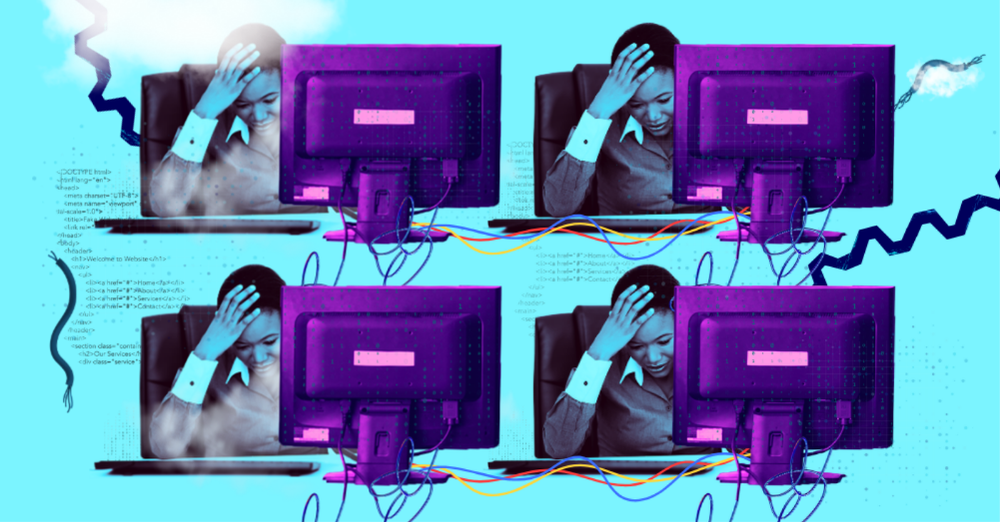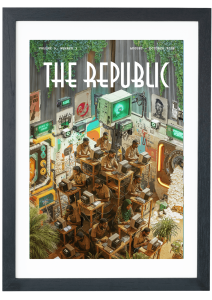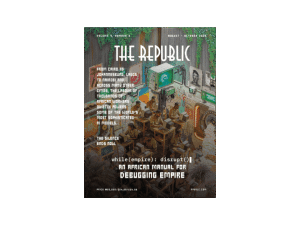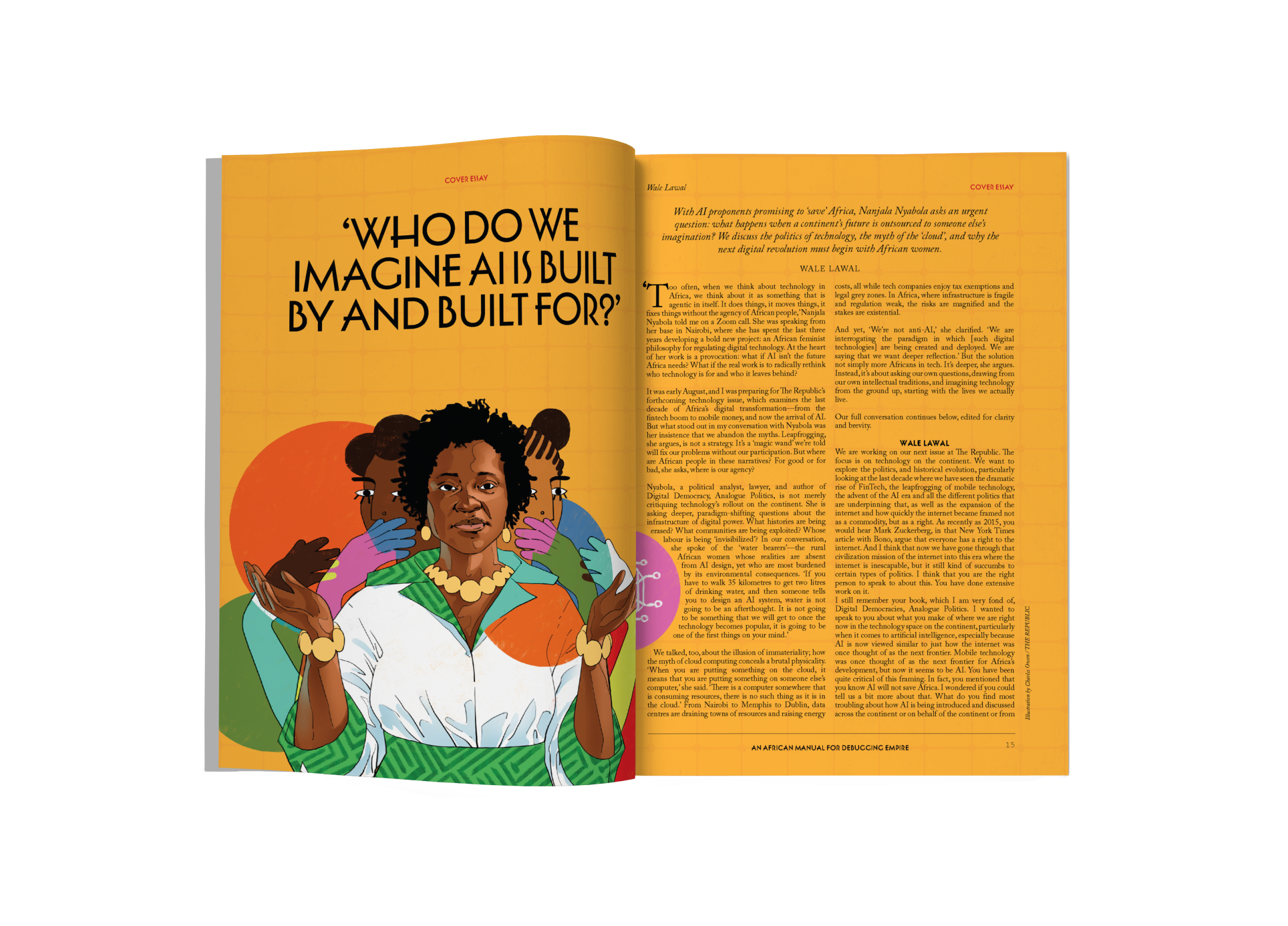
Photo illustration by Dami Mojid / THE REPUBLIC.
THE MINISTRY OF climate change
Africa’s Role in the Future of Artificial Intelligence

Photo illustration by Dami Mojid / THE REPUBLIC.
THE MINISTRY OF climate change
Africa’s Role in the Future of Artificial Intelligence
When most people think of artificial intelligence, the image that comes to mind is of a chatbot on a phone. An app that edits emails, solves math problems or generates an itinerary for a trip. For many people in high-income countries, AI is becoming an almost essential technology. Data from the 2024 Real-Time Population Survey, a nationwide survey by the United States Census Bureau, revealed that 40 per cent of the US population aged 18 to 64 use generative AI to some degree. From search engines to customer service, AI is rapidly altering how we access and process information.
While these tools feel cutting-edge and completely novel, humans have been on the quest to study and develop machines that mimic human intelligence for decades. In 1955, John McCarthy, an American computer scientist and professor emeritus at Stanford University, coined the term artificial intelligence. He defined it as, ‘the science and engineering of making intelligent machines.’ Since then, AI has evolved beyond academic theory, powering a range of applications from navigation systems to medical diagnostics. Ongoing research and improvements to AI have compounded to create what we know the technological landscape to be today.
As AI moves from research labs into everyday life, its implications extend far beyond the technical. It no longer exists as merely a scientific inquiry, but as a social force—reshaping our ways of living and working. Understanding who builds these systems, who benefits from them, and who may be left behind is now, more than ever, a critical part of the conversation. This is especially true when we consider the complex and often overlooked nature of Africa’s relationship with AI.
AUTOMATION AND THE STATE OF WORK
The world witnessed the beginning of a new phase of technological revolution in November 2022 when OpenAI launched its generative AI chatbot, ChatGPT. Within days, millions of users were using it to write code, summarize documents and assist with a wide variety of tasks across industries. However, generative AI is not an entirely new phenomenon. From 1964 to 1974, Joseph Weizenbaum, a professor of computer science at MIT, developed ELIZA, a natural language programme that created a conversational interaction similar to what might occur between a psychotherapist and a patient. This was an early glimpse into the potential of machines to mimic human-to-human interaction.
From ELIZA to Siri and, now, ChatGPT, these innovations are more than just technological curiosities. They represent increasingly sophisticated forms of automation, capable of performing tasks that were once thought to be solely in the domain of human workers. These tools can write emails, translate documents and generate reports; in some cases, acting as a direct substitute for human labour.
Since the early days of computing, humans have imagined a future with intelligent machines. In these worlds, we think of these devices as sometimes helpful, but mostly threatening to replace or even rule over us. Movies like 2001: A Space Odyssey (1968), I, Robot (2004) and Ex-Machina (2014) have brought these anxieties to life, portraying sentient intelligent machines as both exciting and unsettling. These worlds, though imagined, have shaped cultural consciousness and the perceptions of AI, not simply as a tool, but potentially as a competitor or victor in the labour market.
As a result, the rise of intelligent machines and AI-driven tools has fuelled increased public discourse on the place of people in the future of work. Particularly, these conversations revolve around the possible displacement of certain kinds of white-collar and knowledge-based jobs, some of which, like legal and marketing assistants, were previously thought to be immune from automation-induced displacement. These concerns have driven a wave of research focusing on understanding how such technologies reshape the labour market and impact workers. Even now, most of what we know about the interactions between technology and the labour market comes from studies focused on high-income countries, with formalized work, stable policy environments and better labour protections.
For decades, economists have grappled with the question of whether technology complements human labour by increasing productivity or displaces it by making certain roles redundant. Seminal work by David Autor, Lawrence Katz and Alan Krueger in 1998 laid some of the early foundation for assessing these dynamics. Their inquiries and research from many other scholars have helped to categorize technologies into two forms. As either labour augmenting—creating new opportunities and increasing effective labour input—or as labour displacing, leading to job losses or stagnated wages for affected workers. These findings have shaped labour market policy design and business strategies in the Western world.
However, Africa’s labour context is strikingly different. Ours operates under some fundamentally different conditions, many of which existing research fails to account for. For example, most of Africa’s labour force engages only within the informal sector. Also known as the informal economy, the informal sector comprises all economic activities, jobs and workers that are unregulated by the government. According to the International Labour Organization, 85 per cent of global employment is informal, and 93 per cent of the world’s informal employment is in emerging and developing countries. This branch of the economy relies on important labour that is broadly considered as low skill. This means that AI is largely evolving and advancing at a faster rate than the skills of workers in Africa are developing. With informal work dominating employment and high unemployment rates, rapid technological adoption is unfolding along a different path from the West. Applying the same frameworks without adapting to the labour climate risks misunderstanding what automation truly means for the continent.
shop the republic
-
‘The Empire Hacks Back’ by Olalekan Jeyifous by Olalekan Jeyifous
₦70,000.00 – ₦75,000.00Price range: ₦70,000.00 through ₦75,000.00 -
‘Make the World Burn Again’ by Edel Rodriguez by Edel Rodriguez
₦70,000.00 – ₦75,000.00Price range: ₦70,000.00 through ₦75,000.00 -
‘Nigerian Theatre’ Print by Shalom Ojo
₦150,000.00 -
‘Natural Synthesis’ Print by Diana Ejaita
₦70,000.00 – ₦75,000.00Price range: ₦70,000.00 through ₦75,000.00
AFRICA’S PLACE IN THE GLOBAL AI DEBATE
Currently, the picture of technological advancement spotlights places like Silicon Valley, New York City, Seattle and Beijing. News headlines are dominated by breakthroughs from companies like OpenAI, Google and Anthropic. These narratives leave Africa at the periphery, and more often, completely unmentioned. When Africa is brought up in the global AI discourse, it is positioned as a technological landscape that must catch up or adapt to technology built with Western contexts in mind. However, this framing obscures the more complex reality: Africa and Africans are already deeply embedded in the AI and broader tech ecosystem. In truth, they are an essential part of how intelligent machines are developed, trained and refined.
From Cairo to Johannesburg, Lagos to Nairobi and across many other cities, the labour of thousands of African workers quietly powers some of the world’s most sophisticated AI models. These individuals, more popularly known as content moderators, label images, flag harmful content, transcribe speech and annotate data that machine learning models need to learn. Their labour, often sourced and performed through third-party contracting platforms, is key to making AI and AI-based tools functional and safe. Nevertheless, they exist largely as invisible workers, rarely acknowledged for their contributions by the corporations whose models rely heavily on their work.
Even as their work forms the basis of billion-dollar technologies, these Africans experience poor working conditions, attracting low pay (sometimes as little as $1.46 an hour), all the while being exposed to disturbing content and denied proper labour protections. The irony is glaring: while African countries are often discussed as being on the margins of large-scale AI and technological advancements, African workers are central to its continuity. This disconnect between what is visible and what is valued raises urgent ethical questions about who gets to benefit from AI.
WHO IS CREDITED? WHO BEARS THE COST?
Africa’s invisible AI workers represent much more than a minor omission. They are symptomatic of deeper structural inequities and inequalities rooted in the universal digital economy. These dynamics are evidence of a form of digital colonialism, where the infrastructure, capital and profits generated from AI are concentrated in the global North, while the data, labour and risk are outsourced to the global South. Historical colonial patterns of resource extraction and control are reinforced today by Western tech companies engaging in the extraction, synthesis and control over user data by Western tech companies in African countries with limited infrastructure, data protection and labour laws.
When viewed through a labour rights lens, the conditions for workers employed by foreign companies in African countries bring forward a need to interrogate the state of dignified labour on the continent. International labour standards emphasize the right that all workers have to fair wages, safe working conditions and the right to group action. However, for many workers in data centres across Africa, these rights remain widely out of reach. Unfortunately, the current value chain of AI systems disenfranchises those at the bottom while concentrating gains to the top.
If the global AI industry is to indeed be equitable, the first step must be recognizing, fairly compensating and protecting the labour that sustains it. Moving beyond models of extraction and towards systems that respect and dignify the people who contribute their labour to production and make these technologies possible.
shop the republic
AI AND CLIMATE VULNERABILITY IN AFRICA
Recently, much of the global conversation around AI has expanded beyond efficiency, automation and productivity to include the ways these technologies are inextricably linked with environmental sustainability efforts. These implications for Africa are especially critical because of the continent’s position and severe vulnerability to climate change-induced environmental risk.
Africa is home to 19 per cent of the world’s population, but is responsible for only 4 per cent of global carbon emissions. However, the continent is disproportionately affected by the wide-ranging impacts of a changing climate. From increasing temperatures, erratic rainfall, coastal recession and increased droughts, Africa’s people are at the frontline of suffering from the disruptions and displacements that stem from climate change. This is particularly troubling since dependence on land and natural resources remains high. In this setting, AI has the potential to either be a catalyst for deepening climate-related inequalities or a tool for building climate resilience.
At its best, because of its capability for storing and processing large volumes of data, AI can support in mitigating climate change and enable societies to adapt. Machine learning tools can provide vast amounts of environmental data, from satellite imagery to weather-related information. Thus, they can be used to improve the current climate models to allow for better predictions, warning systems and optimizing planning for various communities. For example, AI models are being used to predict land use changes using spatial data related to soil type and proximity to infrastructure. These predictions are useful for forecasting shifts in land use patterns, equipping people and policy makers to better manage resources and plan for sustainable use.
While these technologies have the potential to support climate adaptation, their adoption and development also pose high environmental costs, especially relating to energy consumption. Large-scale AI models like those utilized in generative AI applications require massive amounts of computational power, which results in dependence on energy-intensive data centres. A data centre is a physical facility that houses computer systems used to collect, process, store and distribute data. These facilities are resource-intensive, requiring not only large amounts of electricity for computation, but also significant amounts of water and cooling infrastructure to maintain efficient operation. On account of how much energy they consume, data centres globally are already responsible for about three per cent of global greenhouse gas emissions, even more than the aviation industry. Moreover, these numbers are projected to rise as AI becomes more integrated into global supply chains, business and everyday life.
On the continent, data centres are emerging and largely welcomed as a symbol of growing capacity in the digital sector. Countries like Nigeria, Egypt, Kenya and South Africa are rapidly expanding their infrastructure to accommodate centres owned by large multinational tech firms. However, this shift brings forward some important considerations and questions. Whose data is being stored and processed? Whose energy is being consumed?
Many of the data centres in Africa are operated by global tech companies. Since 2020, companies like Microsoft and Amazon have partnered with African countries to develop data processing centres. While many of these investments promise improved local connectivity, their primary focus is on their global operations, as the bulk of data they service originates from and is servicing clients outside the continent. In the absence of deliberate policy design, African countries are at risk of becoming digital processing zones, hosting data infrastructure without securing any value for themselves.
Right now, the African continent is home to over 100 data centres. These centres run nonstop and derive most of their energy from carbon-intensive grids in countries still struggling with energy insecurity and unreliable electricity. If continually powered by fossil fuels, the expansion of AI infrastructure on the continent could intensify carbon emissions and put local energy systems under undue pressure, further exacerbating Africa’s current climate challenges. For example, South Africa is a country that still struggles with regular power blackouts and inconsistent electricity supply. However, the country hosts a number of data centres and supports them even with its limited energy infrastructure. Without proper regulation, these could entrench other forms of digital colonialism: extracting local resources (water, land, energy, data) to support foreign technological innovations, while worsening local climate and economic conditions.
To ensure climate-conscious and beneficial AI development, local governments and private actors must prioritize building green, inclusive infrastructure. Such as encouraging green technology use in data centres and building local capacity to give room for the ownership, maintenance and use of African data.
shop the republic
LABOUR DUALITIES: OPPORTUNITY AND DISPLACEMENT
African labour markets are largely defined by dualities: formal and informal, local and digital. In recent years, one of the most visible shifts has been with the rise of the gig economy. Labour market disruptors in the form of ride-hailing services or online freelancing platforms have taken up a large share of the continent’s workforce. For young people, especially, these short-term, task-based employment opportunities provide some flexibility and income generation possibilities in the face of high unemployment. However, these jobs are also often unprotected by labour laws and largely unpredictable.
At the same time, rapid AI advancements threaten to stifle progress in this growing subsection of the labour market. Many jobs available in the gig economy rely on the performance of tasks like translation, web design, customer support and transcription, many of which are easily automated by generative AI and large language models. As these tools become more capable, there is an increased risk of displacing the kinds of freelance work that millions of young Africans are increasingly reliant on. Thus, AI development on the continent must seek to identify ways these technologies could augment rather than replace this kind of labour.
As home to the youngest population in the world, Africa’s youth population could be one of the continent’s greatest assets in wading through this new and ever-changing digital landscape. With proper investments in education, infrastructure and labour protection frameworks, African countries can reimagine what inclusive AI innovation and development could look like. To do this would require moving beyond the current picture of production and labour efficiency towards progress that prioritizes people and creates technologies that supplement livelihoods, rather than undermine them.
Already, there are some examples of these sorts of tools that are leaving positive marks on African labour markets. In agriculture, startups like Nigeria’s Kitovu provide farmers with climate-smart farming tools, enabling them to optimize their yield. Kenya’s Hello Tractor connects tractor workers and smallholder farmers, allowing them to access mechanization services previously out of reach. These tools are examples of ways that intelligent systems could be deployed to provide solutions that improve the welfare of African people.
African governments have a crucial role, not just as regulators, but as architects of a digital future where AI enhances, rather than erodes, access to economic opportunity. Here, the goal should be to harness the potential of intelligent systems while prioritizing protecting and preserving vulnerable workers. Administrators all over the continent have a responsibility to invest in digital infrastructure, electricity, broadband access, and mobile connectivity. This will ensure that people everywhere, both in rural and urban areas, can actively and safely participate in the ever-growing digital market. They also have a responsibility to design and implement policies that protect workers in digital settings. The fundamental lies in treating the African worker not as an expendable input in a large technological market, but as an active stakeholder in a shared, equitable and prosperous future.
In global discussions on AI, Africa is often treated as an afterthought. As a landscape onto which innovations are projected, rather than a region already shaping and experiencing AI in profound ways.
AI development cannot be dissected outside the broader structures of global labour markets, environmental justice, and digital colonialism. Behind the sleek interfaces of chatbot technologies and large language models, African workers exist, underpaid and working under gruelling conditions. When we think and talk about the capabilities of intelligent machines, we must ask ourselves: whose data, whose land, whose labour, and whose energy are being used to sustain these systems? Moreover, do indigenous communities benefit from their use?
Going forward, Africa’s story with and in AI does not have to be one of continued marginalization. Our rapidly growing youth population, rising digital adoption and renewable energy potential position the continent to lead the world into a more equitable, sustainable, and people-focused AI future. Realizing this future requires intentional choices from both public and private actors alike. Governments must make the necessary investments in green data infrastructure and research. Global institutions must partner with African stakeholders as equals and not just as a source for extraction. This technology as we have come to know it must be reimagined, not as a substitute for human labour, but as a tool that augments it and preserves the dignity of human work and resilience.
The future of AI is being built, literally, by the hands of African workers. Will Africa remain an invisible thread woven into the fabric of the global AI industry, or will it rise to be a co-creator of a more inclusive and just technological world?⎈
BUY THE MAGAZINE AND/OR THE COVER
-
‘The Empire Hacks Back’ by Olalekan Jeyifous by Olalekan Jeyifous
₦70,000.00 – ₦75,000.00Price range: ₦70,000.00 through ₦75,000.00 This product has multiple variants. The options may be chosen on the product page -
The Republic V9, N3 An African Manual for Debugging Empire
₦40,000.00
US$49.99












